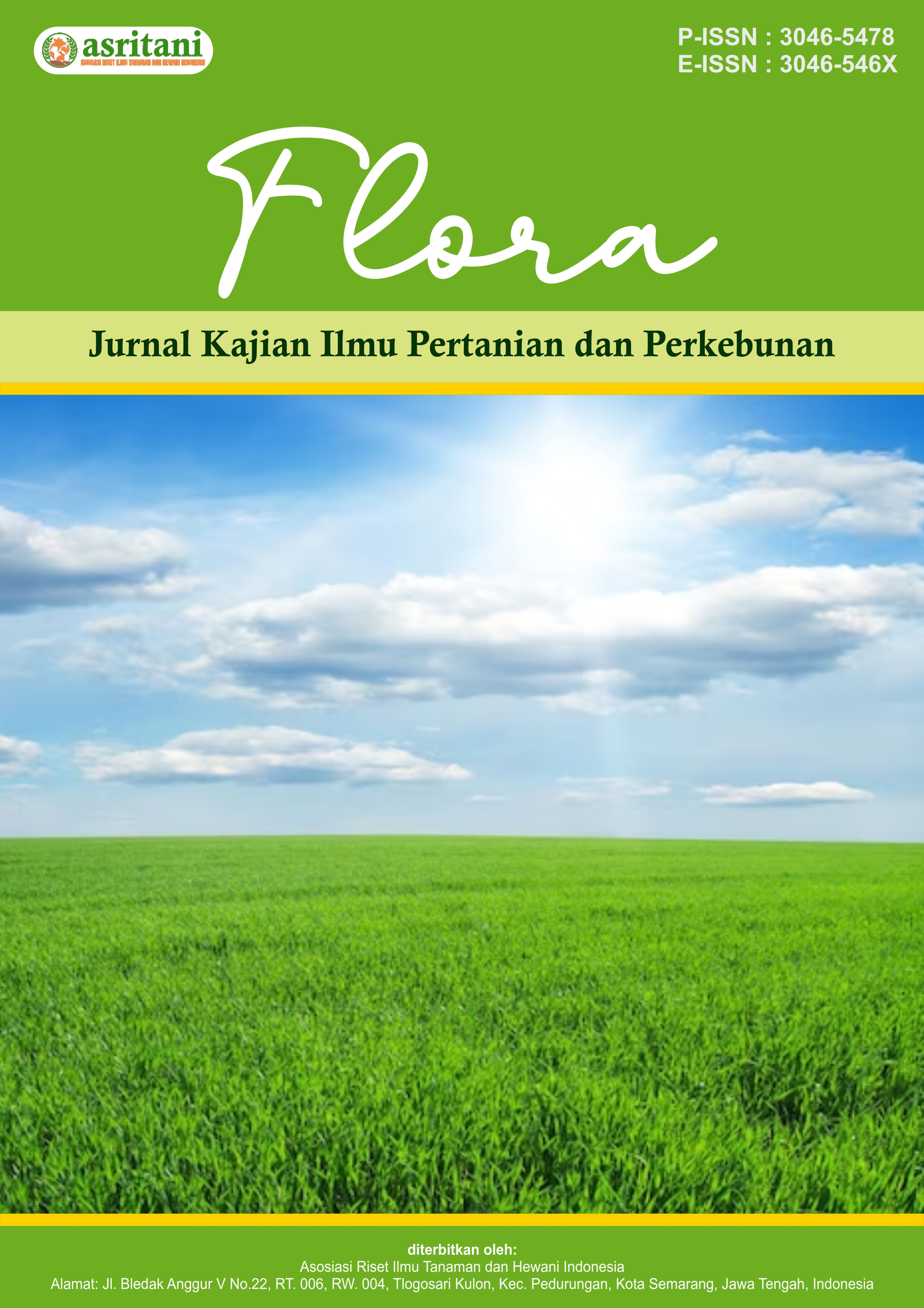Evaluasi Kualitas Sensoris Kopi Robusta Berdasarkan Variasi Pengeringan dan Suhu Penyangraian
DOI:
https://doi.org/10.62951/flora.v2i2.404Keywords:
robusta coffee, cupping test, drying method, roasting temperature, flavor qualityAbstract
Robusta coffee is one of Indonesia's leading commodities with high economic value. The flavor quality of coffee is greatly influenced by post-harvest processes, particularly drying methods and roasting temperatures. This study aims to determine the effects of two drying methods—Viss Dryer and Mason Dryer—and three roasting temperatures (190°C, 197°C, and 200°C) on the flavor profile of robusta coffee at PTPN I Regional 5 Kebun Malangsari. The evaluation was conducted through cupping tests by trained and untrained panelists. Parameters assessed included aroma, flavor, aftertaste, salt/acid, mouthfeel, and balance. The results showed that roasting temperature significantly affected aroma and flavor, with 200°C yielding the highest scores across panelist groups. Drying methods had a more limited effect; trained panelists preferred coffee dried with the Mason Dryer, whereas untrained panelists favored coffee dried with the Viss Dryer. Other parameters such as aftertaste, salt/acid, mouthfeel, and balance showed no significant differences among treatments. The optimal combination, based on trained panelists’ evaluations, was achieved using the Mason Dryer with a roasting temperature of 200°C. These findings underscore the importance of precise roasting temperature control in enhancing the sensory quality of robusta coffee and reveal how panelist experience levels can influence sensory preferences for drying methods. The results provide practical insights for post-harvest coffee processing to improve product quality and competitiveness in both national and international markets.
References
Alfatah, M. W. (2022). Pengaruh suhu dan waktu penyangraian (roasting) terhadap sifat fisik, kimia dan organoleptik kopi robusta (Coffea canephora) di Sugi Coffee dan Roastery Ngadirejo. Laporan Tugas Akhir. Program Studi Teknologi Hasil Pertanian. Politeknik Enjiniring Pertanian Indonesia, Kementerian Pertanian.
Amanda, S., & Rosiana, N. (2023). Analisis daya saing kopi Indonesia dalam menghadapi perdagangan kopi dunia. Forum Agribisnis (Agribusiness Forum), 13(1), 1–11. https://doi.org/10.29244/fagb.13.1.1-11
Asmono, S. L., Alwi, A. L., Nugroho, S. A., & Firmansyah, S. F. (2024). Uji hedonik dan cupping test kopi arabika (Coffea arabica L.) Rengganis Jember berdasarkan perbedaan pengolahan pascapanen. Agropross: National Conference Proceedings of Agriculture. Politeknik Negeri Jember, 13–14 Juni 2024, 148–155.
Baihaqi, B., Fridayati, D., Akmal, A., Desparita, N., & Hakim, S. (2022). Kajian strategi penerapan teknologi pascapanen pada rantai pasok kopi ditinjau dari aspek susut pascapanen. Jurnal Teknologi Pengolahan Pertanian, 4(1), 18–28. https://doi.org/10.37341/jtpp.v4i1.17271
Budi, D., Mushollaeni, W., Yusianto, & Rahmawati, A. (2020). Karakterisasi kopi bubuk robusta (Coffea canephora) Tulungrejo terfermentasi dengan ragi Saccharomyces cerevisiae. Jurnal Agroindustri, 10(2), 129–138. https://doi.org/10.31186/j.agroind.10.2.129-138
Drsowiyono, S., Purwanto, Hartanti, S., Nufus, M., Masyithoh, G., & Aryani, W. (2023). Pendampingan tanaman kopi arabika secara agroforestri di Desa Tokawi, Kecamatan Nawangan, Kabupaten Pacitan. Journal of Community Empowering and Services, 7(2), 54–60.
Herlina, Y. (2022). Pengaruh suhu dan lamanya penyangraian terhadap kualitas biji kopi robusta. Jurnal Agrica Ekstensia, 16(2), 49–56.
Juliawan. (2022). Proses pengeringan kopi robusta (Coffea canephora) dengan vis dryer di PTPN XII Kebun Renteng Pabrik Rayap Kabupaten Jember [Laporan Magang, Politeknik Negeri Jember]. Program Studi Manajemen Agroindustri, Jurusan Manajemen Agribisnis.
Mardiana, R., Shidiq, S. S., Widiastuti, E., & Hariyadi, T. (2021). Pengaruh suhu roasting terhadap perubahan kadar lemak, kadar asam total, dan morfologi mikrostruktural kopi robusta. Prosiding The 12th Industrial Research Workshop and National Seminar. Bandung, 4–5 Agustus 2021. Politeknik Negeri Bandung, hlm. 151–156.
Ngaku, M. A., & Kaleka, M. U. (2024). Prinsip penanganan pascapanen biji kopi arabika guna meningkatkan mutu produk di Kabupaten Ngada. Jurnal Teknologi Peternakan, 1(1), 39–47.
Pelia, L., Sariani, Ladonu, I., & Simayang, W. (2023). Potensi lahan tanaman kopi robusta di Kecamatan Lobu Kabupaten Banggai. Cemaral, 20(1), 39–44.
Purnomo, A. B. (2022). Proses pengeringan kopi robusta mesin Mason dryer [Laporan Praktik Kerja Lapang, Politeknik Negeri Jember]. Program Studi Keteknikan Pertanian, Jurusan Teknologi Pertanian.
Rwanda, R., Mutama, R., Surya, M. H., & Dewi, B. S. (2021). Pengaruh pengelolaan kopi robusta terhadap kondisi sosial ekonomi masyarakat di HKM Binawana Register 45B Desa Tri Budisukur, Kecamatan Kebun Tebu, Lampung Barat, Lampung. Jopfe Journal, 1(1), 1–10.
Waang, S. K., Lalel, H. J. D., Abidin, Z., & Cakswindryandani, N. L. P. R. (2023). Studi penangan pascapanen kopi robusta di Kabupaten Alor. Agrisa, 12(2), 99–105. https://doi.org/10.29303/agr.v12i2.14185
Wahyuni, N. L. E., Rispiandi, R., & Hariyadi, T. (2020). Effect of bean maturity and roasting temperature on chemical content of robusta coffee. IOP Conference Series: Materials Science and Engineering, 830(2), 022019. https://doi.org/10.1088/1757-899X/830/2/022019
Downloads
Published
How to Cite
Issue
Section
License
Copyright (c) 2025 Flora : Jurnal Kajian Ilmu Pertanian dan Perkebunan

This work is licensed under a Creative Commons Attribution-ShareAlike 4.0 International License.





